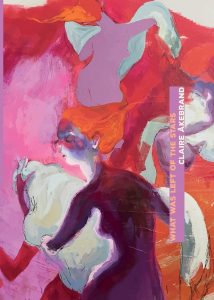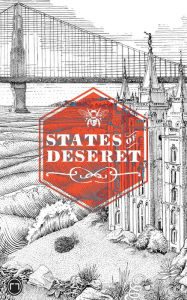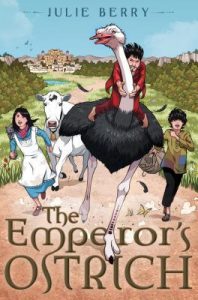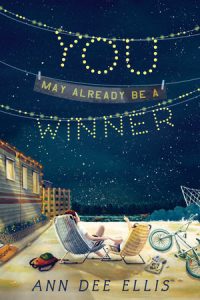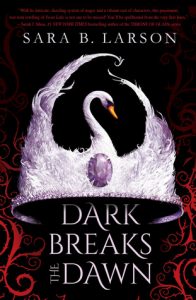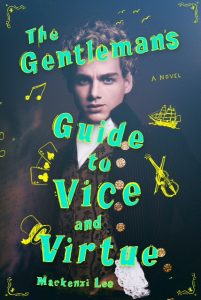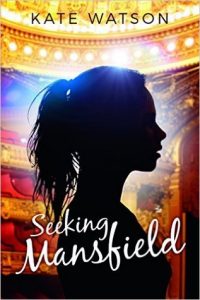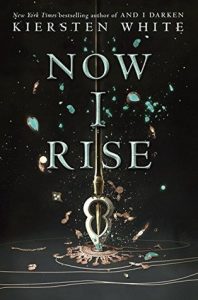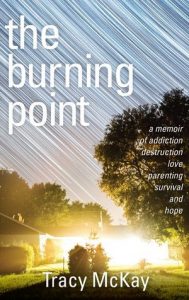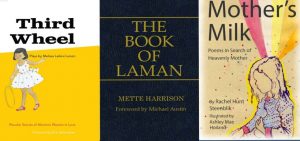The Mormon Arts Center Festival in New York City was called, by Terryl Givens, “a seminal event in Mormonism’s coming of age artistically.” The Mormon Lit Blitz is a great opportunity to enjoy quality flash fiction on Mormon themes, and the latest issue of Dialogue provides us with a cascade of short stories, poems, essays, and reviews. New books include poetry collections from Claire Åkebrand and Lisa Bickmore, a Mormon alternative history story collection edited by William Morris, Dan Wells’ final John Cleaver horror novel, and well-reviewed juvenile fiction from Julie Berry, Ann Dee Ellis, Emily R. King, Sara B. Larson, Mackenzi Lee, Kate Watson, and Kiersten White. T. C. Christensen’s latest movie Love, Kennedy was released. Finally, BCC Press is swinging into high-gear in July, publishing four literary works with LDS themes: a Book of Mormon novel by Mette Harrison, plays by Melissa Leilani Larson, a memoir by Tracy McKay, and an illustrated poetry collection on Mother in Heaven by Rachel Hunt Steenblik and Ashley Mae Hoiland. Please send news and announcements to mormonlit AT gmail DOT com.
Mormon Arts Center Festival
The first Mormon Arts Center Festival was held June 29 to July 1 at the Riverside Church, New York City. Glen Nelson and Richard Bushman were the main organizers.
KSL television news story, including segments with Glen Nelson, Richard Bushman, J. Kirk Richards, Dave Checketts, Ethan Wickman, Craig Jessop, and President Dieter Uchtdorf.
Salt Lake Tribune piece, by Peggy Fletcher Stack. “In his keynote address, LDS author Terryl Givens called the festival “a seminal event in Mormonism’s coming of age artistically.” David Checketts, investment banker and former CEO of Madison Square Garden, signed on to raise money, Gordon Smith, one of the church’s area authorities, asked the financier to get involved, said Checketts, who described himself as “a passionate supporter of the arts.” He readily agreed. Ultimately, the group hopes to find a permanent home for Mormon art in New York, taking its place alongside other institutions such as the Jewish Museum of Art, located on Fifth Avenue near the Metropolitan Museum of Art. Checketts envisions a space close to the LDS chapel and temple in the Lincoln Center neighborhood. He doesn’t know how long it will take to build, he said, but “it’s an idea whose time has come.” Hurtado was particularly delighted to introduce the crowd to the work of Jorge Cocco Santangelo, a Mormon from Argentina. He dubbed his style “sacrocubism,” a term he coined that combines post-cubist forms with religious subject matter. The Utah-based faith commissioned Santangelo to create 16 paintings on the life of Christ. The series, acquired in 2016, is “being considered” for the New Testament Sunday school manuals next year, Hurtado said, “shifting finally away from [Seventh-day Adventist painter] Harry Anderson.”
“Where are the Mormon Shakespeares and Michelangelos?” Jana Reiss, Religion News Service. Jana reports on a presentation she gave at the Mormon Arts Center Festival. “I pointed to the outsized presence of Mormon novelists who make up the ranks of genre novelists, particularly for the YA market . . . A few years ago a piece in the New York Times put it down to a couple of things: 1) Mormon writers can’t depict sex, so they have fled adult fiction in favor of writing for teens, and 2) Mormons already have such an outlandish theological orientation that science fiction really isn’t much of a stretch. There is probably some truth to the first of those assertions, but I don’t think it gets to the heart of things. Closer to the truth is Rosalynde Frandsen Welch, who has pointed to Mormons’ ability to fulfill community expectations as a key component of success. Genre fiction lives and dies by how well authors adhere to certain community expectations, and Mormon authors have proven themselves to be geniuses at community. They not only understand the literary requirements of their respective genres, but they help one another succeed, and give of themselves to readers in events and on social media. What I came away with in that talk was that community is the Mormon Shakespeare. The “lone genius” paradigm is not our jam. That’s not to say we don’t have immensely talented individuals in our midst, many of whom I have been privileged to meet here at the festival. But it means that Mormons’ peculiar gift is for pulling together, believing that our individual efforts are part of something bigger. That we have a responsibility to nurture one another.”
High quality videos of several of the presentations are available at the Mormon Arts Center YouTube Page.
Eric Samuelsen’s presentation, “Neil LaBute, Tim Slover, Melissa Leilani Larson.” Read by James Goldberg. Samuelsen takes on the “Shakespeares and Miltons of our own” quote.
Jana Riess. “Genre Triumphs: The Outsized Mormon Presence in Young Adult and Middle-Grade Fiction.”
Steven L. Peck. Reading from Gilda Trillam: Shepherdess of Rats.
Also videos of presentations by Kristine Haglund, Jared Hickman, Glen Nelson, Laura Allred Hurtado, Francisco Estevez, an exhibition walkthrough, and Consecuencia.
The exhibition catalogue, Immediate Present, was available at the festival, and is available for purchase. “Immediate Present examines the Mormon art of today, by bringing together a range of works-from explicitly religious paintings to the varied artistic practices of those who self-identify as Mormon, to works that shed light on Mormon themes. Published on the occasion of the exhibition, Immediate Present, part of the Mormon Arts Center Festival. This publication is a sampling of works created in the last three years by twenty-three artists: Pam Bowman, Whitney Bushman, Stephanie Kelly Clark, Jorge Cocco Santangelo, Caitlin Connolly, Jeff Decker, Daniel Everett, Rachel Farmer, Jeff Hein, Ben Howell, Levi Jackson, Brian Kershisnik, David Chapman Lindsay, Jason Metcalf, Annie Poon, Walter Rane, J. Kirk Richards, Jean Richardson, Ron Richmond, Mary Sauer, Casey Jex Smith, Page Turner, and Chase Westfall. The publication includes the pairing of commissioned texts with the paintings. Like the artists themselves, the individuals whose words are featured in this book have distinct backgrounds-a lawyer, a doctor, a game warden, a poet, a children’s book author, a composer, a musician, and a women’s rights advocate-just to name a few. The twenty-three writers are: Claire Åkebrand, English Brooks, Joanna Brooks, Sam Brown, Claudia Bushman, Alex Caldiero, Tyler Chadwick, Steve Evans, Fiona Givens, James Goldberg, Ryan Habermeyer, Julie de Azevedo Hanks, Ashley Mae Hoiland, Garrick Infanger, McArthur Krishna, Igor Coelho Arantes Santana Marques, Neylan McBaine, Carol Lynn Pearson, Jennifer Reeder, Analisa Coats Sato, Rachel Hunt Steenblik, Paul Washburn, and Chrysula Winegar.” A collection of scholarly papers from the symposium will come out after the Festival.
James Goldberg was the guest on the first Mormon News Report Podcast, run by Brian Whitney and Brandt Malone, the creators of the excellent This Month in Mormon Studies podcast. James talks about his background and artistic projects. He reports on the Mormon Arts Center Festival, where he gave a presentation, and talks about his own background and projects. On the question of “Mormon Shakespeares and Michelangelos”, he commented, “Brandon Sanderson is the Mormon Dostoevsky. He has these epic fantasy novels, which are also interesting moral discourses, where you have questions raised in one scene with one set of characters, and then implicitly answered with other characters later, which is a very Dostoevsky thing to do. On the question of “What is Mormon art?”, he said, “The definition I like is that which is defined by the audience, art that resonates in some way with Mormons. I think in some ways we are looking for who is the Mormon superstar, who will give us the cultural affirmation that we crave, because we have this provincial self-doubt, and we want someone else to tell us we are good.”
News and Blogs
The 6th Mormon Lit Blitz of flash literature was held in May and June. The winners were announced, 1). “Forty Years” by Jeanna Mason Stay. 2) “Celestial Accounting” by Kathy Cowley. 3) “On the Death of a Child” by Merrijane Rice. 4) “Pride” by Hillary Stirling.
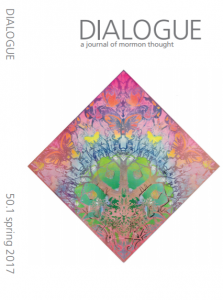 The Spring 2017 issue of Dialogue: A Journal of Mormon Thought is out. It includes:
The Spring 2017 issue of Dialogue: A Journal of Mormon Thought is out. It includes:
Short fiction: William Morris. “The Darkest Abyss in America,“ and R.A. Christmas “Le Train à Grande Vitesse”.
Personal essays by Kylie Nielson Turley, Frances Lee Menlove, and Paul Nibley.
Poetry by R. Bassett, Laura Craner, Elizabeth Garcia, Terresa Wellborn, and S. E. Page.
Jon Ostenson reviews two YA novels: Julie Berry’s The Passion of Dolssa and Jeff Zentner’s The Serpent King.
Jennifer Quist reviews Jack Harrell’s Writing Ourselves: Essays on Creativity, Craft, and Mormonism.
Emily Shelton Poole reviews Julie J. Nichols’ novel Pigs When They Straddle the Air.
Mahonri Stewart reviews Thomas F. Rogers’ Let Your Hearts and Minds Expand: Reflections on Faith, Reason, Charity, and Beauty.
Julie J. Nichols reviews Shawn Vestal’s novel Daredevils.
Mary Bradford reviews Stanton Harris Hall’s poetry collection Just Seeing.
Michael Austin. “The Dime Novel Hero in Salt Lake City: Popular Fiction and the Contested Mormon Embrace of Modernity, 1890–1903.” MHA presentation, on the Greg Kofford Authorcast.
Steven L. Peck is a semi-finalist for the Big Moose Prize for unpublished novel, for The Tragedy of King Leere, Goatherd of the La Sals.
“In the Gloaming: The Grit Lit of Larry Menlove.” 15 Bytes. Interview by David G. Pace. “Somewhere between Chuck Palahniuk of Fight Club fame and the late Harry Crews lies the unsettling genre of Grit Lit. Or maybe the genre spawns and seethes between the two poles of Cormac McCarthy and the firefighter-turned-novelist Larry Brown, the latter deceased at a too-tender age . . . So what’s a nice post-Mormon Utah boy doing writing this stuff? Well, truthfully, he’s not in bad company if you consider that he’s in the same boat as, arguably, Mo-writers of the ur-text of Grit Lit, fiction writer Brian Evenson and playwright/screenwriter Neil LaBute,”
Darlene Young, “Book Report” Darlene blogs about reading books about Mormons”. “Recently I abandoned an LDS-themed (Mormon characters) book, A Song for Issy Bradley, by Carys Bray. It reminded me very much of another LDS-themed book that was also written by a writer from the UK, The Friday Gospels by Jenn Ashworth. While I did finish The Friday Gospels, I felt very bogged down, in both books, by the time taken in world-building (that is, creating the sense of Mormon culture) . . .To me all the mentions of the inspirational wall-hangings, Sunday-school platitudes, kitsch, etc. felt inauthentic. Not because I didn’t recognize these things, but that I felt it was a violation of the characters’ points of view to NOTICE them. This is a tricky thing I try to explain to my students: when you are in a certain character’s point of view (even if it’s a somewhat distant third-person), mentioning details is tricky, because it feels to your reader in a subtle way as if the character is noticing those details. And so the mention of all these details, which are very common in my culture, made me lose trust in the narration because I think a character who has grown up with these things, seen them every day, wouldn’t notice them in particular on this day just because his/her story has now begun . . . So when there is so much (unnecessary) detail in a Mormon book, I assume it’s there for one of two reasons: either the author is not, or only minimally, LDS, and wants to show off her research, or she feels that this cultural stuff is somehow pertinent to the story. I like neither of these situations. I’m so tired of the “poor thing; look at the crazy stuff she had to grow up with” story, in which there is always the chastity anecdote of the fondled flower or the chewed gum. I want a Mormon fiction that is as complicated and beautiful (as well as sometimes tragic) as our culture is, and I think too many books go for the low-hanging fruit. And it shows. And I’m tired of it.”
Wm Morris writes about “Remembering Jonathan Langford the critic” and “Artists and Doctrine & Covenants section 58” at A Motley Vision.
Stories and personal essays
Scott Russell Morris. “Reunion”. When Kirsten and I traveled through Europe a few years ago, I wrote a series of “postcards,” — brief essays / prose poem things. Happy to have one of them featured as this week’s “Beautiful Things” over at RiverTeeth Journal. http://www.riverteethjournal.com/blog/2017/05/29/reunion
Wm Henry Morris. “Storytime at the White Hart.” Big Echo: Critical SF. Inspired by Arthur C. Clarke’s “The Ultimate Melody” (1957, If).
Steven L. Peck. “At the End of the Eight Volume Epic: All I Want is a Warm Bath and a Good Scroll”. The Centropic Oracle.
Brad R. Torgersen. “CASPer’s Ghost”. In A Fistful of Credits: Stories from the Four Horsemen Universe. Seventh Seal Press, June 29. An anthology of stories from the Four Hoursemen Universe. “CASPer’s Ghost” tells the story of a mecha-armored merc who has been dropped onto the surface of a Venus-like hell world. He quickly discovers that there’s a lot more going on, than just a hunt for rare resources. Soon he’ll have to join forces with a rival, while uncovering some damning evidence about the boss—while *also* trying to figure out how to get back to orbit.
New Books
Claire Åkebrand. What Was Left of the Stars. Serpent Club Press, May 12. Poetry. She is a Segullah poetry editor, and a Poetry MFA student at the University of Utah. Her debut novel is also coming out later this year.
Marlene Bateman. Searching for Irene. Covenant, July 1. Romantic suspense. Anna Coughlin is a modern 1920s woman armed with a college education and a partiality for numbers. Now, within the walls of a fantastic castle-like mansion in the hills of Virginia, her skill will be tested as never before.
Jennie Hansen, Meridian. 4 stars. “All in all, the characters are believable, fit their time period, yet are unique. The book is absorbing and will keep the reader turning pages. Even though I guessed the identity of the killer early in the novel, I still found the story an engrossing read.”
Julie Berry. The Emperor’s Ostrich. Roaring Book Press, July 17. Middle grade fantasy/adventure. “Young dairymaid Begonia has lost her cow, Alfalfa. So she has set off on a search across the countryside even though she has nothing but a magical map to guide her. Along the way she meets a mother and baby, a woodcutter, a very dirty young man, and an eight-foot ostrich. Meanwhile, the Emperor has gone missing from the royal palace in a most mysterious manner. Was it murder? Was it magic? It will take all of Begonia’s wits to save the empire and get Alfalfa home safely.”
PW: Berry creates a lively, magic-laced folktale featuring a self-centered emperor, a dairymaid, a farmer boy with grand romantic ideals, and two very stubborn animals. It begins when two ancestral spirits decide to teach the 21-year-old bully of an emperor a lesson, kidnapping him and leaving him on the road with no companion except an eight-foot-tall ostrich. In a nearby village, Begonia is searching for her wandering cow when she runs into Key, who has left home to seek his fortune. Believing Begonia is a damsel in distress, Key insists on being her escort, and they soon cross paths with the unrecognizably bedraggled emperor. Disastrous predicaments ensue, and the travelers find themselves on a mission to save the empire, which has been usurped by a scoundrel who makes the original emperor “look like a saint.” Whimsical details, including an enchanted map and a pot of mustard that changes flavor, will delight readers, and the nonstop action will keep them on the edge of their seats.”
SLJ: “ This novel is well written and well executed, with Berry’s clear prose holding together a complicated plot and increasingly eccentric cast of characters. VERDICT Give to kids who enjoy a clever story and don’t mind a strong dose of silliness, or to anyone who loves the idea of a cow who becomes besotted with an ostrich.”
Kirkus: “The evocation of the emperor and his palace relies on Orientalist tropes, but the countryside where the bulk of the story takes place feels like many a faux-European medieval countryside. Begonia, Key, and the emperor are drawn on the cover with black hair and light skin, though the emperor has the look of a movie Genghis Khan. Cheeky commentary about class and feminism, giggle-inducing wordplay, and jokes about the ridiculousness of imperial overindulgence round out this story. Readers looking for easy laughs will find them here.”
Jessica Day George, 5 stars. “Such a fun adventure story! Julie calls it her love letter to Lloyd Alexander, and it certainly reminded me of Alexander, but also of Miyazaki’s Studio Ghibli films, and a little bit of The Nightingale (the only Hans Christian Anderson story I can tolerate). But I did more than tolerate this: I loved it! I was really not expecting the twists and turns the story would take, or the fanciful characters, but I adored how they all came together in the end. This book has one of the best jailbreaks in history, and also features the only case of cow-ostrich romance that I can think of! I swear, every one of Julie’s books gets even more amazing. Just when you think she’s hit the pinnacle of her talent, she finds a new level of awesome, so this book holds the current title of Julie’s Best Book.”
Lisa Bickmore. Ephemerist. Red Mountain Press, June 15. Poetry.
Teyla Branton. Sketches. White Star Press, June 20. Dystopian science fiction. Colony 6 #1.
Chelsea Curran. Unseen Road to Love. Cedar Fort/Bonneville, May 9. LDS romance.
“From the outside, Logan Atwood’s life looks perfect: a successful career, a lavish lifestyle. But after a brutal car accident leaves him in a coma, Logan suddenly finds himself five years in the past. Only then does he realize that his perfect world may have cost him the woman of his dreams and the faith he once loved. Is it too late for Logan’s second chance?”
Jennie Hansen, 4 stars. “Chelsea Curan has created characters facing today’s real problems and set them in a world that contains all the temptations and misguided values of the real world. She is an extremely promising new author.”
Sarah M. Eden. Romancing Daphne. Covenant, June 1. Regency romance. Lancaster Family #3.
Mindy Holt. 5 stars. “Romancing Daphne is perfect. I loved that it was another story for the Lancaster family . . .There were so many clever and heartwarming moments. I loved Daphne right from the start. I loved her growth and how as her and James got to know each other her confidence grew. James was wonderful too. 5 out of 5 stars. Sarah is a fantastic author, every time I read another book of hers it becomes my new favorite.”
Jennie Hansen. 4 stars. “Sarah M. Eden’s characters are believable and in spite of the time difference, the reader feels she can easily step into their shoes. The dialog feels right, and the setting is thoroughly researched for accuracy. Along with the technical details of a well-written story, Eden manages to convey in a non-preachy way a sound moral lesson. This award winning author is one LDS fiction’s most highly sought after novelists.”
Bloggin’ ‘bout Books. B-. “Sarah M. Eden is a master at penning warm, witty novels full of earnest characters, sparkling repartee, and swoon-worthy romance. Romancing Daphne is no exception. Daphne is an undeniably empathetic heroine, a woman whose fears and insecurities make her extremely relatable. James is likable as well, although both of the lead characters are somewhat overshadowed by the more colorful personalities of The Duke of Kielder and young Artemis Lancaster. An engaging cast overall. Although I enjoy slow-building romance, the Romancing Daphne does feel overly long. I don’t read much romance; when I do, I like it short and sweet. The story gets formulaic and predictable, too, but honestly, that’s what I’ve come to expect from this genre. All in all, I enjoyed Romancing Daphne. It’s nothing original or mind-blowing, but it’s a fun read, the kind of light snack I like to consume between heavier literary meals.”
Sarah M. Eden. My Dearest Love. July 11, Mirror Press.
Ann Dee Ellis. You May Already Be A Winner. July 11. Middle grade general. “For fans of Ali Benjamin’s The Thing About Jellyfish and Katherine Applegate’s Crenshaw comes the humorous and heart aching story of one girl’s struggle to keep hope alive for her and her younger sister in Sunny Pines Trailer Park.”
SLJ: “With her father gone and her mother working overtime, there is never enough food, money, or attention in 12-year-old Olivia Hales’s life. She enters multiple contests a day because the words, “You may already be a winner” give her hope for a better future. She takes care of her little sister Berk during the day, even skipping school to do so. When neighbor boy Bart notices that Olivia has been sacrificing school and friendships to care for her younger sister, he tells on her, bringing her carefully constructed plans to an end. The quirky characters and drama keep the story interesting and imaginative. The young characters deal with divorce, abandonment, and adult responsibilities. Short chapters include letters Olivia writes to her father. VERDICT Recommended for readers who enjoy realism with roller-coaster emotional arcs.”
Kirkus: “A turning point when Olivia’s ordered to return to school and must secretly stow Berkeley strains credulity but is suspenseful and triggers an emotional, satisfying climax. Ellis develops her supporting cast with nuance and increases readers’ investment in Olivia with such details as her heartbreakingly one-sided correspondence to her father. Readers of this memorable novel will feel like winners, too. ”
Mette Ivie Harrison. The Book of Laman. BCC Press, July 24. “A serious novel by an accomplished novelists exploring the perspective of Laman, the villain of the first part of the Book of Mormon. In the manner of Jean Rhys’ Wide Saragossa Sea and John Gardner’s Grendel, Harrison teases out the sympathetic story behind a figure that generations of readers have feared and despised.” Foreword by Michael Austin.
Catina Haverlock and Angela Larkin. Beyond. Cedar Fort, June 13. YA supernatural. Debut novel. “Presley Hale has no idea the guy she just told off in the school parking lot died in a drowning accident four months ago. Why would she? It’s not like she knows she can see the dead. Stunned by Presley’s sixth sense, Landon Blackwood rethinks his planned departure and begins tracking her to find answers to their mysterious connection. When their complicated relationship turns dangerous, they learn that tampering with the boundaries of death comes with consequences. Can Landon save Presley from the insidious spirits who have marked her for death, or was their love doomed from the beginning?”
Mindy Holt, 5 stars. “I really enjoyed this book. Beyond reads quickly, with a very entertaining plot and very likable characters. Presley is a great character. I loved her relationship with Chase, it was very sweet. Being his caregiver was hard, but she did it well. I loved the story line and where the authors took it. I enjoyed the POV switches between Landon and Presley. The climax was entertaining and heart-pounding, but I felt it we could have used a little more on the Vigilum. I know the story was about Landon and Presley, but I enjoyed the idea of the Vigilum and wanted to see them more. The ending did seem a bit rushed. That being said, the book was entertaining and I felt satisfied at the end. I was not able to guess where it would go or how it would end! I honestly could have gone either way.”
Stacy Henrie. The Renegade’s Romance. Harlequin, July 4. Western romance.
Jean Holbrook Matthews. Winds of Change. Deseret Book, May 1. LDS historical romance. “The year is 1854, and change is in the air throughout India. Within the walls of her grand home in Calcutta, Sarah McCune anxiously awaits the future. After eighteen months at war, her husband, a sergeant in the Bengal Army of the East India Company, has made an extraordinary proposal: leave all the comforts of their life in Asia for an unknown future in America. As recent converts to Mormonism, Sarah and her husband are drawn to the promise of Zion. So, despite their fears regarding the dangerous voyage before them, they and their four children embark on a journey of faith that will test the limits of their conviction and define generations to come. This breathtaking saga, based on the historical journals of one LDS family, invites readers to experience the sacrifices and perils of these early pioneers as they faithfully seek a land of promise.”
Jennie Hansen. 4 stars. “A fictionalized account of a real family that played an important role in the history of the West and especially in Utah . . . The author has committed impressive research toward the background of this book. From the East India Company and British rule of India with the wars and intrigues of that period to the realities and poverty of immigrants arriving in New York, and the long, difficult trek west, the so-called Mormon War, and the settlement of western communities, she imbues the story with touching, accurate details that bring the story to life. Not only does she relate the political and human aspects of the different stages, but she adds enough of the plant, wild life, and topography to add visual depth. Though this story is clearly historical, it also is a story of complicated human emotions and is a study of the part faith plays in determining each individual’s journey through life.”
Michelle Paige Holmes. Yesterday’s Promise. Mirror Press, July 5. Historical romance. Set in 1761 in the Scottish Highlands.
Kari Iroz. Mormon Girl Incognito. Covenant, June 1. Romantic suspense. Sequel to A Date With Danger. Hilarious heroine Jacklyn Wyatt is back—this time in a dicey Vegas adventure! Jacklyn “Jack” Wyatt is just your average Mormon girl—other than her brief stint with the FBI, her subsequent brush with death, and her dreamy boyfriend, Special Agent Damon Wade.
Bloggin’ ‘bout Books: B. “The thing that I like about her books is that they don’t take themselves too seriously. They’re rom-coms more than anything else. Our heroine, Jack Wyatt, is hilarious. She’s a funny, vulnerable, self-deprecating Everywoman who’s impossible not to like. Damon has less personality, but he’s got hidden depths that I hope will be explored more in further novels (I’m keeping my fingers crossed for many more installments in this series). Even more so than A Date With Danger, the happenings in Mormon Girl: Incognito are highly implausible; even still, they’re totally entertaining. I very willingly suspended my disbelief so I could follow along on Jack’s misadventures in Vegas and, you know what? No regrets. I had a great time tearing through this fun, lighthearted novel. Sure, it’s far-fetched, but who cares when it’s such an enjoyable read? If you dig clean romantic comedy/suspense with a light sprinkling of LDS doctrine/culture, then you really ought to check out Jack Wyatt. She’s a gem.”
Emily R. King. The Hundredth Queen. Skyscape/Amazon, June 1. YA fantasy romance. “An orphan girl blossoms into a warrior, summoning courage and confidence in her fearless quest to upend tradition, overthrow an empire, and reclaim her life as her own.”
VOYA: “This title offers a gripping plot with twists and turns, a unique setting, and strong female characters—a solid foray into the fantasy romance genre. Fans of Marissa Meyer and Leigh Bardugo will find this new series captivating.”
SLJ: “Filled with many action-packed sequences, forbidden romance, and unexpected surprises, this debut fantasy will appeal to teens who enjoy epic dramas with strong female characters. VERDICT Recommended for libraries where Kiera Cass’s The Selection is popular.”
Kirkus: “King writes multiple strong female characters, led by Kalinda, who has the loyalty and bravery of spirit to defend her friends even if that means facing death. Kalinda narrates in the genre-conventional present tense, revealing to readers her resistance to the rajah’s cruel manipulations: “if the gods have indeed brought me here, then they know that I will not bend to him. Not now. Not ever.” A prefatory note states that Kalinda’s world is inspired by but not grounded in Sumerian mythology. Strong characterization, deep worldbuilding, page-turning action scenes and intrigue, as well as social commentary, make this book stand out. This outing opens a trilogy; readers will be eager to get their hands on the next installment.”
Rosalyn Eves. 5 stars. “I wasn’t sure what to expect going into this book, but I found it fresh, vivid, well-plotted, and intriguing. I think my favorite thing is the way the story grapples with faith–how it informs one’s life and one’s decisions, how one creates agency within a faith tradition. Looking forward to the next one!”
Melissa Leilani Larson. Third Wheel: Peculiar Stories of Mormon Women in Love. BCC Press, July 24. Two play scripts. “Little Happy Secrets,” which won the AML award for drama in 2009, explores same-sex attraction among a pair of roommates at BYU. “The Pilot Program,” which won the same award in 2015, imagines the re-introduction of polygamy in a childless Mormon family. Also features a foreword by Eric Samuelsen.
Sara B. Larson. Dark Breaks the Dawn. Scholastic, May 30. YA fantasy. First of a series.
PW (Starred): “Larson deftly weaves fantasy with the best parts of the Swan Lake ballet in this gripping first book of a duology. The kingdoms of the Éadrolan and the Dorjhalon have been engaged in a bitter war for 10 years, costing thousands of lives. Queen Ilaria now leads the forces of the Light, much to the dismay of her daughter, Evelayn. After Evelayn ascends to Éadrolan’s throne unexpectedly early, following her mother’s death, Evelayn grapples with learning how to control her newfound powers and how to be an effective wartime ruler. One of the powers inherent to royals is the ability to assume animal form, something Evelayn struggles with throughout, and her attempts to balance her personal and professional lives is mirrored in the give and take between the Éadrolan and Dorjhalon. Larson is especially effective in her portrait of Evelayn’s need to summon maturity before she thought she would have to, a sweetly innocent romance underscores the bite of betrayal, and the cliffhanger ending will easily build anticipation for the second book.”
VOYA: “Readers who relish lush, colorful descriptions that stimulate the senses will not mind occasional odd shifts in perspective or some slow parts in the plot, and the action picks up as the book progresses. The intricate writing feels ideal for the high school level, yet there are no issues in content that make it inadvisable for younger teens as well. In this reimagining of Swan Lake, the characters deal with issues of morality and justice and the burdens of responsibility; these universal themes flourish in Larson’s fantastic setting. Likeable supporting characters will likely take on a greater role in the sequel, which readers will eagerly await, given the cliffhanger ending. This is a recommended purchase for all libraries that serve teens who enjoy the fantasy genre.”
Kirkus: “Larson’s latest novel contains many of the tropes found in modern fantasy adaptations: a feisty princess, dastardly villains, epic fights, and a love triangle. The worldbuilding is intriguing and the matrilineal conveyance of power is a neat twist, but the novel’s fascinating premise is undermined by its too-fast pacing. Readers are not given enough time to really invest in Evelayn’s struggles or the supporting characters’ before the main adventure gets underway, resulting in Evelayn’s lapse into caricature. An appealing if imperfect girl-power fantasy that ably sets the stage for its sequel.”
Mackenzi Lee. The Gentleman’s Guide to Vice and Virtue. Katherine Tegan Books, June 20. YA historical romance/adventure. “A young bisexual British lord embarks on an unforgettable Grand Tour of Europe with his best friend/secret crush. An 18th-century romantic adventure for the modern age.“ Also see “In Which I Solve a Maurice Sendak Mystery, by Mackenzie Lee”, a 2013 blog post by Lee about a Maurice Sendak illustration on the cover of a 1969 issue of the Children’s Friend, a LDS magazine.
PW (Starred): “Eighteen-year-old Monty Montague—scandal prone, acid tongued, and a bit too fond of boys, girls, and gin—is embarking on a grand tour of Europe, a last hurrah before taking up the mantle of lordship. The tour quickly veers off course for Monty, his longtime friend (and not-so-secret crush) Percy, and his headstrong sister Felicity when Monty and a young lady are caught in a compromising situation at Versailles, after which Monty absconds with a small trinket. Pursued by the Duke of Bourbon, Monty learns that the object may hold the key to unlocking powerful alchemical secrets. Without funds or connections, the three haphazardly make their way across the continent, crossing paths with secretive Spanish siblings, an inexperienced pirate crew, and others. It’s a gloriously swashbuckling affair, but Lee doesn’t shy from addressing the era’s overt racism, sexism, homophobia, and prejudice regarding illness. Percy, a biracial epileptic, and Felicity, a young woman dreaming of medical school, are well-rounded and fascinating supporting characters, and the romantic relationship that develops between Monty and Percy is sure to leave readers happily starry-eyed.”
SLJ (Starred): “From the start, readers will be drawn in by Monty’s charm, and Felicity and Percy come alive as the narrative unfolds. The fast-paced plot is complicated, but Lee’s masterly writing makes it all seem effortless. The journey forces Monty and friends to confront issues of racism, gender expectations, sexuality, disability, family, and independence, with Monty in particular learning to examine his many privileges. Their exploits bring to light the secret doubts, pains, and ambitions all three are hiding. This is a witty, romantic, and exceedingly smart look at discovering one’s place in the world. VERDICT A stunning powerhouse of a story for every collection.”
Kirkus (starred): “The book’s exquisite, bygone meter and vernacular sit comfortably on a contemporary shelf. And the friction of racism, tyrannical entitled politicians, and misguided disapproval of homosexuality also have a relevance rooted in current culture’s xeno- and homophobia. Austen, Wilde, and Indiana Jones converge in this deliciously anachronistic bonbon.”
Booklist (Starred): “Tongue-in-cheek, wildly entertaining, and anachronistic in only the most delightful ways, this is a gleeful romp through history. Monty is a hero worthy of Oscar Wilde.”
Dene Low. Charming Lady Etta. Laurel Wreath Publishing, April 21. Fantasy romance. “Lady Etta Wrexham is young, newly wealthy, and shipwrecked. Lord Charles Shelton is handsome, wealthy, and Lady Etta’s rescuer. What starts as the answer to Lady Etta’s romantic prayers, ends in adventure, danger, and magic because Lord Shelton is not what he seems. But, then, neither is Lady Etta.”
Tracy McKay. The Burning Point. BCC Press, July 1. Memoir. “A Memoir of Addiction, Destruction, Love, Parenting, Survival and Hope.”
Russell Fox, Goodreads. 4 stars. “I can’t think of anyone I know who I don’t want to read this book. Tracy McKay’s story–of her love for her husband David, of her struggles as David’s addiction to painkillers eventually destroyed their marriage, and of her slow, determined rebuilding of her and their children’s lives–is a great and inspiring one. Everyone has stories that they don’t tell–embarrassments and pains and humiliations and confessions and arguments that parents and friends and children keep quiet, hidden away in the closets of the mind. Tracy brings her hard story out, hiding nothing, and everyone who reads this story of survival will be blessed by it, I think. Much of it is heart-rendingly sad, but there are great moments of triumph as well, and there’s the occasional laugh-out-loud funny bit as well. More importantly, her story will inspire you to hang on through the tough times, to pick yourself up with you think you’ve hit bottom . . . Her memoir may not be everyone’s cup of tea–her writing is lyrical, poetic, and introspective, even when straightforward description might serve her narrative better. And the way it jumps around in time, following Tracy’s own freely associating memory, might rub some people wrong. But still, I hope everyone will give this book a chance, because Tracy’s story is a great one, and much worth sharing.”
Kellie, Segullah. “From a literary/wordcraft consideration, there is a thrumming lyrical skeleton under the rolling curves, valleys and scars of McKay’s experiences. Symbols of light, silence and vastness are shared, shrouded and stunningly revealed over the pages, just as we are shown how they appeared over the years of her experiences. The resonance of a revelatory loop is bone deep in places; sinew of sorrow and succinct detail tie threads from a moment with butterflies at the beginning of the book to a pre-dawn closure of another fragile loop in the last few pages, the symmetry of prose and symbolism beautifully crafted . . . The memoir uses different styles exceptionally well, especially considering the timeline is not presented linearly. Excerpts from blog posts begin each chapter, then moving to different years, places and conversations. The first-person narrative is also interspersed with interludes, where the moment is told in third person, which oddly – and beautifully – gives both a compassionate deepness to and momentary reprieve from the deep waters of life McKay was finding herself in . . . As a read guaranteed to singe your assumptions, thump your heart, and wrap an encouraging arm around your scared, uncertain shoulders as you face off against disappointment and life’s unknowns, The Burning Point is a must-read, and stunning besides.”
Wm Morris, editor. States of Deseret. A Motley Vision, May 30. Alternative-history short story collection.
Christian Anderson (AML). “The new anthology States of Deseret sends out a few pioneers into this territory in the form of eight bite-sized stories, which both use and spin the tropes of the genre, hinting at greater things to come . . . While not the most technically sophisticated, the story I enjoyed most in the collection was Anneke Garcia’s “Richard Meets the Missionaries”, where an investigator in Britain is hesitant to join the predominantly black LDS church, founded by Joseph Smith after his family moved to Liberia in the 1820s as part of the Back-to-Africa movement . . . Mormon writers have a unique combination of training to think about unknowable histories, and the opportunity to describe resettling a known cultural identity in a new history from the inside. These stories prove that the tried-and-true methods of the AH genre work with Mormon themes, and that a Mormon inflection can add texture and novelty to the standard models. Rather than finding the edges of the field, these stories merely hint at the limitless possibilities yet to be explored. In short, the pages are white, already for handwriting. I look forward to being able to lay up in store a great many LDS Alternative Histories in this world’s near future.”
Gabriel González (AML). “States of Deseret is a short story collection set in alternate histories of the Mormon Church. The collection asks the “what if…?” question eight different times, in eight different ways, with eight different outcomes. Some of the authors I quickly recognized as old pros in the craft of writing; others I was unfamiliar with. Whatever the case may be, the eight stories, with their eight different styles, come together in a very satisfying way. The editor did a fantastic job with his selection. Each story was entertaining, and more importantly, each had an interesting point to raise. Even so, to appreciate some of the stories, readers really need to know their Mormon history… and some gentile history as well. So people who are not historically inclined would more than likely not appreciate the stories as much . . . “Subject to Kings” by Lee Allred. This was my favorite story in the collection. The stakes are high. The tension is palpable. It boasts Nazis, international espionage, complex characters, and an open ending. It is masterfully crafted, as one would expect from a successful, professional writer like Allred. The point of divergence occurs before the short story’s opening, which is set in the year 1938 at a time when the Republic of Deseret, the Confederate States, and the Texas Lone Star Republic exist independently of the United States. The likes of Hermann Goering and J. Reuben Clark play key roles in the plot. After reading it, one is left with the lingering question of whether we can effectively recognize conflicts between our political loyalties and our spiritual values . . . f that is your cup of tea, then this book should be on your must-read list. Oh, and if you are looking for something based strictly on its entertainment value, there’s something for you here too.”
Tiffany Odekirk. Love on Pointe. Covenant, June 1. Contemporary romance. Debut novel. “Rhys Solario has a secret, one he plans to keep: he’s a non-Mormon attending Brigham Young University. With only two semesters left before graduation, he just wants to keep flying under the radar. Then he meets Emmy in a Book of Mormon class, and for the first time, the idea of keeping to himself doesn’t sound so appealing. Emmy Jennings feels confident only when she’s dancing ballet. But when she fails to earn a coveted solo, her confidence on the dance floor disintegrates and the future she’s worked so hard to earn stands in jeopardy.”
Mindy Holt, 5 stars. “I really loved this book. I was immediately taken with the characters. Rhys is a great guy and Emmy is such a sweet and caring soul. I loved her vulnerable side, and I also loved how she was able to grow as well. Rhys has a lot on his shoulders with his mother’s health and he handles it well. All characters were written well and weren’t perfect, I appreciated that. Emmy also has her own struggles. I did feel Rhys’s struggle in telling Emmy the truth and it was handled perfectly. I also enjoyed the “definitions” at the beginning of each chapter. Especially for non LDS who may read the book. It was also a fun “preview” of what the chapters would be about.”
Jennie Hansen. 2 stars. “More YA than adult.”
Bloggin’ ‘bout Books. B-. “An upbeat, swoony romance featuring a likable duo battling an impossible problem. While I found the story’s premise a little implausible, I adored its setting. Odekirk does an admirable job of bringing the BYU atmosphere to life in all its goofy glory, capturing both the fun and frustration inherent in the student experience. She also goes to great pains to break down common stereotypes, although many manage to bleed through. Still, Love on Pointe tackles a difficult situation with honesty and sensitivity. Although it’s obvious from the get-go how the story will end, she throws in a couple of surprises to keep the plot interesting. Not every aspect of the story line rang true for me, but overall I found Love on Pointe an enjoyable read. Yes, it oozes a fair amount of cheese and melodrama; still, it’s a bright, fun, faith-promoting book that will appeal to anyone looking for a clean, easy-to-read LDS romance. While I have a few issues with Odekirk’s debut performance, one thing is certain—I can’t wait to see what she does for an encore.”
Anita Stansfield. Lily of the Manor. Covenant, July 1. Historical romance. Broadbent Manor is a home brimming with life and love. With eleven adopted children in her care, young widow Lily Broadbent is in search of the right tutor to instruct and nurture her young charges.
Rachel Hunt Steenblik (author) and Ashley Mae Hoiland (illustrator). Mother’s Milk: Poems in Search of Heavenly Mother. BCC Press, July 24. Rachel Hunt Steenblik (co-editor of the Oxford University Press volume Mormon Feminism: Essential Writings) has written 246 small poems about the profound human longing for a Heavenly Mother. And Ashley Mae Hoiland (author of One Hundred Birds Taught Me to Fly and creator of the We Brave Women card series) adds her trademark illustration style to the mix.
Laura Stone. And it Came to Pass. Interlude Press, May 18. GLBT Romance, about two male Mormon missionaries. Author is an ex-Mormon.
PW: “Stone tackles forbidden love between Mormon missionaries in this moving and hopeful romance. Adam Young, a former college football player turned missionary who’s just arrived in Barcelona, thinks his companion, Brandon Christensen, is perfect. Brandon is the only Mormon elder to have successfully baptized anyone in the very Catholic city, and he exudes genuine concern and a friendly nature. But timid and reserved Adam starts to realize his feelings for his fellow missionary are not entirely spiritual in nature. When his desire boils over and Brandon catches him masturbating, he discovers that the attraction is mutual. Adam’s confusion about his spirituality and sexuality ring very true, and the descriptions of his harsh upbringing by cold, demanding parents (unlike Brandon’s delightful, supportive ones) help explain his turmoil. As the two young men grow increasingly attached and intimate, they’re set on a collision course with Mormon leaders. Stone has an unfortunate tendency toward didactic passages and occasional lapses of accuracy around Mormon life that distract from her lovely prose and well-defined characters. Despite these hiccups, her vital and tender story will deeply engage both Mormon and non-Mormon readers.”
Kirkus: “While there is much to praise here, some aspects of the novel (particularly the language) can be overwrought. In one scene, Christensen notes that his “loins are filled,” then presents his desire verbally to God. Still, it’s refreshing to see devotees of God who are struggling with their sexuality. A fine romance with a touch of political intent.”
SBTB. “Grade: B”. “Their romance is complicated and emotionally staggering, with layers of internal and external tension. I loved the detailed explanation and portrayal of Brandon and Adam’s daily life as missionaries, how they practiced their faith and struggled with it and kept trying to be worthy of the expectations placed on them. There is a lot of detail here about Mormon observance. Once the poo hits the air circulation device, however, the slow and painstaking tension built between and around Adam and Brandon becomes a plot that resolves very, very quickly. The ending was a little too fast for me – I wanted to know more about their future, what they’d do to move on with their lives, or what direction their faith might take. There is a lot that’s left open and unfinished, and while Brandon and Adam are safe, I wanted to know more about the foundation of their happiness, because it has to be constructed on entirely new ground . . . I loved the way their romance included exploration of their faith, and their fearless examination of divine love as interpreted by their church vs described by the scriptures . . . Because of the first 2/3 of the story, I know how devastating that would be for Adam and for Brandon; because the last 1/3 doesn’t fully balance their losses with a potentially happy future, I was left unsure and wanting more.:
Kate Watson. Seeking Mansfield. Flux, May 1. YA romance. Debut novel.
Kirkus: “In a modern spin on Mansfield Park, Watson’s debut blends Austen with a dash of Shakespeare, all in contemporary Chicago. Sixteen-year-old Finley Price, “half-Brazilian, half-Irish,” has found a sanctuary with her wealthy white godparents and their son, the Bertrams, after escaping her abusive mother. She is hyperaware of her perceived debt to the Bertrams and is determined to avoid being an imposition and to give back as much as she possibly can. Ever protective Oliver Bertram, however, is consistently encouraging her to be bold and embrace life. When white sibling Hollywood teen stars Emma and Harlan Crawford move in with their aunt and uncle next door the homeostasis of the Bertram home is disrupted. Finley must learn to speak up for herself to heal past wounds and move forward to achieve her dreams. The third-person narration shifts focus between Oliver and Finley, giving insight into the motives of each, including their unspoken affection for each other, which simmers throughout the novel. Austen’s Regency plot fits well among contemporary teens trying to define their own values and ambitions away from family obligations, expectations, and psychological baggage. Watson avoids the satire of the original, though, as this Finley and indeed all the characters seem to be entirely in earnest. A commendable adaptation of a 200-year-old tale made fresh for a 21st-century audience.”
VOYA: “While the plot remains quite predictable, the characters are interesting and the romantic tension between Oliver and Finley is fun. The dialogue waffles between “teen speak” and old-fashioned, proper phrasing. This can be jolting, making teen characters sound far older and more mature than their years. Finley has survived her mother’s violence and appears to suffer from PTSD, but the topic is not fully explored. This is not a novel for fans of Jane Austen’s classic. The retelling is clichéd and simplistic, but if readers are looking for a light, romantic read with a heaping dose of melodrama, Seeking Mansfield will be perfect.”
SLJ: “The narrative begins with stiff language, perhaps too reminiscent of that of the original Austen work, but eventually settles into a more comfortable style. Similarly, characters’ personalities start off caricature-like before the author grasps deeper layers of each one, fleshing out subtleties and contradictions with finesse. With a classic plot to build on, this title successfully illustrates gray areas of human nature and communicates them in a way readers will see reflected in their own lives. This novel will satisfy fans of the source material and Austen neophytes alike. The book’s complex themes will be enjoyed by fans of Estelle Laure’s This Raging Light and Rainbow Rowell’s Fangirl. VERDICT This debut ultimately weaves an impressive mosaic and is an excellent selection for fans of young adult literature that is heavily thematic or romantic or that revisits the classics.”
Dan Wells. Nothing Left to Lose. Tor, June 6. Horror. John Cleaver #6. The last of the series.
Jessica Day George. 5 stars. “Yep. He did it. I know I shouldn’t have doubted, but still. When you write a series about a sociopath fighting monsters, and you make the reader care about that sociopath, and actually about some of the monsters, you are painting yourself into a bit of a corner. How to end the series in a way that feels real, but isn’t just devastating to the reader? This. This is how. This is how you end a series that pulls no punches, that gets super dark, in a way that is satisfying and honest, without being so depressing that the reader can never feel joy again.
Kiersten White. Now I Rise. Delacorte, June 27. YA fantasy/historical. The Conqueror’s Saga #2. Game of Thrones-like YA fantasy adventure, set in the Ottoman Empire, with a female Vlad the Impaler.
Kirkus (Starred review): “The Dracul siblings experience power’s price in this middle volume of a trilogy that imagines a female Vlad the Impaler. Despite Sultan Mehmed’s initial backing, Lada has made little ground in securing the Wallachian throne. She writes Radu a letter asking for his assistance, as she lacks his interpersonal strengths and way with courtly politics. Radu, however, desperate to close the distance between himself and Mehmed, prioritizes romantic love. Lada must make her own (violent) way as she struggles to be seen, and she makes her own dark choices on both sides of tough betrayals. Meanwhile, Mehmed sends Radu away to Constantinople as a double agent right before launching a brutal siege. This puts Radu (and Radu’s wife, Nazira, a believer in Mehmed’s cause since her true wife suffered greatly at the hands of crusaders) in position to sabotage Constantinople but also to admire enough of the people for it to hurt. The siege’s depiction is viscerally painful—brutality and atrocities from both sides shake Radu deeply. The complex politics and sprawling world make for a dense, rich read. Human nature’s contradictory depictions are exquisite and painful. Tender-hearted Radu cares for Lada, but it’s brutal Lada who loves Radu; and great, good people commit terrible acts. The multiethnic cast features strong LGBTQ representation and nuanced religious diversity. Lada, Radu, and Mehmed are well on their way to remake the world—but at the cost of their souls. Absolutely devastating in the best way.”
SLJ: “The author crafts a compelling story that also asks important questions about the lengths to which people can and should go to achieve their destinies and defend their god. The pace of this volume is perfect for its setting, and the language is evocative, making the hefty tome eminently readable. The subject matter has become even more mature as this lush and ominous retelling of the Vlad Dracul legend continues, but teens will be entranced. VERDICT This chilling and thrilling new episode in the historical fiction trilogy is highly recommended for all high school collections.”
VOYA: “ This complex historical fiction offers a gender-switched take on the story of Vlad the Impaler, and Lada is as cold and bloodthirsty as her real-life male counterpart. Lada is not just a “strong female protagonist,” she has moments bordering on psychosis. Nevertheless, readers will find her and (perhaps even more so) Radu relatable and human, flawed and engaging. The love triangle with Mehmed is likely ill-fated, but adds a compelling element to the story. This entry may be confusing to readers new to the series, but a glossary and a dramatis personae offer some support for the many characters and potentially unfamiliar words. Those who have read the series starter will reap the most from this volume and revel in the continuation of the story of the Dracul siblings.”
Reviews of older books
Kimberly Johnson. Leviathan with a Hook (Theric Jepson). “Unlike many of the collections I’ve read this year wherein I start excited by the new voice then grow weary of it by the end, I didn’t take to this book at all. It was many pages before I even found lines I liked. As the pages turned, I grew impressed by her innovations but confused by the coherence of imagery—or rather, this coherent imagery’s lack of apparent connection to the collection’s title. And then the third-to-last poem brought that all together. And the final two poems brought us in for a soft landing.”
Steven L. Peck. Science: The Key to Theology (Reviewed by Michal Collings). “I am not going to rehearse Peck’s reasonings and conclusions; they are meticulously developed, often using mathematical proofs (although in general, he allows, one may skip the math and move on…thank you!), just as often using intersections of science and theology from his own experiences. The text perforce relies heavily on the specialized diction—the jargon, it the words most useful sense—of science: ontology, reality (try defining that sometime), truth, belief, knowledge, faith. And much to his credit, since virtually every word needed in the discussions are themselves ambiguously treated in our contemporary world, Peck provides necessary refinements. He even includes pictures among the more esoteric diagrams and formulae.”
Theater
(in)divisible. Plan-B Theatre, SLC, June 8-18. A series of five-minute plays by Utah playwrights presented as part of Plan-B’s Script-In-Hand Series. Our country feels more divided than ever before. People increasingly feel their voices are being ignored. It seems we’ve collectively lost the ability to listen. PLAYWRIGHTS: Austin Archer, Matthew Ivan Bennett, Carleton Bluford, Rachel Bublitz, Elaine Jarvik, Julie Jensen, Jennifer A. Kokai, Melissa Leilani Larson, Jenifer Nii, Eric Samuelsen, Morag Shepherd, Debora Threedy.
Douglas Stewart and Lex de Azevedo. Saturday’s Warrior. St. George Musical Theatre, June 29-July 22.
Carol Lynn Pearson. Mother Wove the Morning. Canyon Glen Park Amphitheater, Provo Canyon. Derrick Clement’s Provo Herald feature story on the play.
Mahonri Stewart’s The Death of Eurydice. Hollywood Fringe Festival, June 3, 9, 23, and 24.
Film
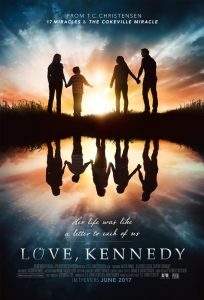 Love, Kennedy. T. C. Christensen, director, writer, producer. Purdie Distribution. June 2.
Love, Kennedy. T. C. Christensen, director, writer, producer. Purdie Distribution. June 2.
Sean Means, Salt Lake Tribune. 2 stars. “Christensen’s movie makes the strong case that Kennedy was a wonderful person who brought joy and warmth to her family, friends, classmates and LDS ward — even in the final year of her short life. But it’s one thing to live a miracle and quite another to depict one on film and pull a compelling drama from it. Kennedy Hansen (played by Tatum Chiniquy) was a normal girl growing up in Ogden, living with two siblings and their loving parents, Heather (Heather Beers) and Jason (Jasen Wade). As Jason’s narration tells us, she wanted to be a cheerleader, wanted to drive and wanted to have a boyfriend. After she suffered some falls at school, the Hansens took her to the doctor, who delivered a horrible diagnosis: Kennedy had Batten disease, a rare neurological disorder in which fats and proteins build up in nerve cells. The disease usually strikes children and teens, progressively affecting vision and motor function. There is no cure, and victims usually die young. Once Kennedy is diagnosed, she and her family are determined to let her live to the fullest for as long as she is able. She cheers at her high school’s football games, and the cheer squad encourage their coach to let her join the team, where she becomes an inspiration. She goes to a church dance, and the boys in the ward cheer her up by asking her to dance. Christensen compiles several of these stories from Kennedy’s short life. Drawing from the Hansens’ community of friends, he fills the movie with authentic details — filming scenes in the Hansens’ house, casting people she knew in minor roles, and deploying her favorite song (Imagine Dragons’ “Radioactive”). A series of episodes from Kennedy’s life, though, don’t add up to an engrossing movie. There’s no dramatic arc or tension between characters, just a slow inevitable slide as Kennedy’s condition worsens . . . “Love, Kennedy” ends with a “miracle,” a story of how Kennedy’s spirit influenced one of her friends (Yvonne D. Bennett) and her family to rejoin the LDS Church. The anecdote makes for an interesting coda and shows the movie’s fate won’t be in theaters but in Sunday school lessons for years to come.”
Hannah McDonald, Deseret News. 3 stars. “T.C. Christensen’s “Love, Kennedy” is touching, but its themes of faith and testimony may feel a little heavy-handed for nonreligious viewers . . . The film has its problems. For one, the dialogue is a little clunky at times, and the movie struggles with pacing. In some scenes, the pacing plays to its favor, giving emotions time to sink in. In others, it detracts from the story. The subplot with the Velasquez family, in particular, feels underdeveloped. Christensen makes large use of voice-over narration when he could have been served better by a little less telling and a little more showing. However, the film has an undeniable poignancy to it. Special mention has to go to Jasen Wade and Heather Beers, who play Kennedy’s parents with realistic and touching emotion. Chiniquy as the titular Kennedy is genuine and convincing in what is no doubt a difficult role. Both Christensen and the actors are effective in eliciting emotional reactions. “Love, Kennedy” will most likely leave audiences sniffling and tearing up at several points throughout the movie. At its core, the film is an exploration of modern faith, and it’s anything but subtle. In some ways, it feels like an LDS missionary lesson about the plan of salvation. “Love, Kennedy” is unquestionably marketed toward LDS viewers. Non-LDS viewers, however, will find it difficult not to sympathize with the Hansens’ story, even if they are skeptical about the film’s religious messages.”
Man in the Camo Jacket. Russ Kendall, director. July 4, various VOD platforms. A documentary about Chris Peters, the Welsh front man for the band The Alarm. Looks at his music, and his recent battle with cancer. Features interviews with Billy Bragg, Billy Corgan, Fred Armisen, and many others. Entertainment Weekly feature story. Guitar World.
Bestsellers
June 4, 11, 18, 25, July 2, 9, 16, 23
Mackenzi Lee. The Gentleman’s Guide to Vice and Virtue
NY Times YA Hardcovers: x, x, x, x, x, x, #8, x (1 week)
Kiersten White. Now I Rise
NY Times YA Hardcovers: x, x, x, x, x, x, #10, x (1 week)
Christine Feehan. Shadow Reaper
USA Today: x, x, #4, #55, #120, x, x, x (3 weeks)
PW Mass Market Paperback: x, x, #1, #6, #13, x, x, x (3 weeks). 21,749, 10,705, 6477 units. 38,931 total
NY Times Print and Ebook fiction: x, x, #3, x, x, x, x, x (1 week)
Christine Feehan, Power Game
USA Today: x, x, x, x, x, #76, #141, x (4 weeks)
PW Mass Market: x, x, x, x, x, #6, #11, #18, x (3 weeks). 9670, 7430, 4764 units. 21,864 total
RaeAnne Thayne. Serenity Harbor
USA Today: x, x, x, x, x, x, #14, #44 (2 weeks)
PW Mass Market: x, x, x, x, x, x, #3, #4 (2 weeks). 14,398, 11,205 units. 25,603 units
NY Times Print and Ebook fiction: x, x, x, x, x, x, #12, x
RaeAnne Thayne. A Cold Creek Secret & Not Just a Cowboy
USA Today: x, #77, #103, x, x, x, x, (2 weeks)
PW Mass Market Paperback: x, #11, #10, #8, x, x, x, (3 weeks). 9955, 9042, 6951 units. 25,948 total.
Brenda Novak. No One But You
USA Today: x, #64, x, x, x, x, x, (1 week)
PW Mass Market: x, #23, x, x, x, x, x, (1 week). 5607 units
Richard Paul Evans. The Broken Road
PW Hardcover: #23, x, x, x, x, x, x, x (3 weeks). 3373 units. 20,718 total

